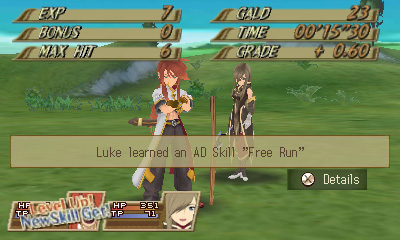Tales of the Abyss (Nintendo 3DS) Review

Nintendo DS has an amazing selection of Japanese RPGs in its library, from fully-fledged 3D remakes of Final Fantasy games to new entries into series previously only seen on consoles, like Dragon Quest IX. It even has three of the famous Tales games that unfortunately never made it to Western shores. 3DS looks set to continue the JRPG trend of the 3DS and change the fate of the Tales games with the release of Tales of the Abyss in Europe, but how does it fare on Nintendo’s handheld?
Tales of the Abyss starts off with a prediction about a red-haired man of royal blood who will bring the land of Kimlasca to prosperity. Enter Luke fon Fabre, a young red-haired man, who is the son of a duke and next in line to the throne. Due to circumstances involving loss of memory and voices in his head, Luke is not allowed to leave the palace's grounds until he turns 20 years old and considered an adult. One day however, while sword training with his master, Van Grants, a mysterious woman assassin attacks Grants. Luke gets in the way, inadvertently magically transporting them to a place far away from the palace.
From here Luke is forced to co-operate with the assassin, Tear, and find his way back home. The story does take a while to get going, but once it does there are many twists that eventually force Luke, Tear and other party members to try to save the world of Auldrant from destruction. Some of the twists are easy to see coming, but all of them keep the story fresh and some of them do actually come as a surprise.
You end up with six party members of varying roles and backgrounds, each using different types of Fonic Artes and magic, although only four characters are available in battle at one time. The real-time battles that occur once an enemy comes into contact with the player’s avatar take place in arenas. For most foes, tapping the A button until they're defeated is enough to get you through, but for stronger enemies you'll have to rack up combos and use Fonic Artes; special attacks unique to each character.

The character you control can use up to eight different Fonic Artes at any given time during battle, with four assigned to the B button combined with the Circle Pad moved in different directions (centred, up, down or sideways) and four assigned to the touch-screen. Each Fonic Arte uses a certain amount of Technical Points, so if you don't have enough points in your TP gauge during battle, you won't be able to use them, although the meter can be filled by striking the enemy with normal attacks.
Fonic Artes can also be used in combination with other characters’ for special effects. For example, when a character (friend or foe) uses an elemental attack on the battlefield, creating a circle of that element, stepping into it and using a Fonic Arte can trigger a special version of it that involves the element -- Luke's Fang Blade turns into a Lightning Fang Blade when mixed with lightning. On top of Fonic Artes, there are also special attacks, one for each character, that can only be triggered in Overlimit mode, activated by pressing right on the D-pad. Overlimit gives characters a temporary increase in attack and defence, and gives them a certain amount of time to trigger a special Mystic Arte. When a Mystic Arte is set off all enemies within range are damaged significantly, with the targeted enemy getting the most damage. Keep in mind though, all bosses can use Overlimit too, and some are even able to use very powerful Mystic Artes that effect all members of your party...
Items are usable in and out of battle, with some having effects of healing both the amount of HP and TP, while others aid status effects including bringing downed characters back to life. There is also a very useful item called the magic lens which lets you see the enemy's HP, and it doesn't have to be used again if you come across the same enemy (unless they're a repeated boss). Weapons and armour are switchable inside battle, so if you didn't equip a strong enough weapon before battle you can always correct that mistake.

Extra strategy when it comes to battle includes the Capacity Core, which is changeable through the menu. The Capacity Core determines how your characters develop in terms of skills throughout the game and can be interchanged and upgraded when you pick new ones up. As your character develops their C. Core they will gain a number of Additional Skills (AD Skills) which can be turned on and off during battle. Another element of battle are the Fon Slot Chambers (FSC) which can be attached to an Arte to add certain abilities. For example, putting a Grass Chamber on Luke's Raging Blast will increase the ability to steal items from enemies. There are four different types of chambers, which each give alternate abilities to various characters: Grass, Cobalt, Sunlight and Carmine. After battle you get a grade which adds to your final score, and after finishing the game you can spend those points on bonuses in a second playthrough.
Outside of battle, you have the overworld of Auldrant to explore in many different ways. Most places are accessible from land, but others can only be accessed by air or sea. In the overworld, the character that is flagged as the leader appears as your avatar to walk around, but they're not necessarily the one you play as in battle, since that is decided by the first member on the list; easy to switch around via the menu. The first four selected are the members who usually enter battle. However, if you are attacked from behind by an enemy on the map, the two characters left out will come into battle instead of the second and third. This is called being out of formation, but it isn't necessarily always a bad thing.
Cooking also makes a return, with up to four recipes known to the group at a time. Food can heighten statistics depending on what's been rustled up and how well-trained the cook is. Ingredients for the recipes are picked up from shops and certain monsters. Along the way you'll also unlock titles for the characters which, unlike previous Tales games, give special effects in the dungeons and towns rather than a stat boost. You might heal while standing on the spot, or get discounts because you're in a certain store.
Not long into the game, Luke is forced to take a young Cheagle with him by the name of Mieu. Mieu can talk to humans because he has the Sorcerer's Ring that was given to him by the Cheagle elder. Mieu can initially only breathe fire with the ring, but as you progress through the story you can collect more abilities that will help you solve dungeon puzzles, including Mieu Smash, Mieu Fly, and Mieu Fire 2. Only the first two are necessary to complete the main storyline, but all are needed to collect everything.

Dungeons are usually full of monsters of different kinds and some have generally straightforward puzzles that get harder throughout, but they’re never too challenging in the compulsory dungeons. There are however extra puzzles laying around in the same dungeons, solely accessible via hidden passages found outside. These puzzles are only necessary to solve if you want to complete the game 100%, but can also be helpful to the characters, yielding hidden weapons and armour that can't be bought from the shops.
Tales of the Abyss’ main story can last 50+ hours, but with the extras adding a lot more on to that -- further puzzles, bosses and items to find -- the game can stretch past the 60 or even 70 hour mark. The game has small non-voice acted skits which pop up when prompts are met with a tap of Start, which add to the story through character's thoughts about the situation, and conversations that can be a little off topic (and sometimes hilarious). Most of the main cutscenes use the in-game engine to tell the story. Though you can skip the dialogue boxes in these scenes you cannot skip a scene entirely, which can get annoying when you've died from a boss a certain amount of times and you just want to get to the battle. Other, less common, cutscenes consist of animé action sequences which show important turning points of the story.
Voice acting is generally good and suits the characters well. There is a lot of Americanisation due to the game being a port of the American version of the original game. The visuals have had a makeover while being ported to 3DS, which has given Tales of the Abyss a watercolour flair; some areas look fairly plain, but others look beautiful with painting-like backdrops. None of this pushes 3DS' power to the max, however, and there are even occasional short spells of slowdown in the overworld. The game does use the 3D to add to the visuals, although it's so subtle that it might as well not be there at all, and the framerate stays the same whether 3D is on or off.
The music is very similar to past Tales games, with the second half of the game's battle music being the most memorable; there are some good tunes in the game, but some of it is quite forgettable. After the game is finished a hard mode is unlocked. This is a lot tougher but feels like a natural difficulty hike over the standard challenge. One thing that may disappoint some is that the multiplayer from the original is missing, but if you like your single player RPGs then Tales of the Abyss does just fine.

Cubed3 Rating
Great - Silver Award

Tales of the Abyss is a great addition to the series with a good story and excellent additions to gameplay. Fans of RPGs and especially fans of the Tales series will love the game, but so will newcomers; it’s a great start to what may be a long line of excellent 3DS RPGs.

![]() 8/10
8/10
![]() 9/10
(6 Votes)
9/10
(6 Votes)
 Out now
Out now  Out now
Out now  Out now
Out now  Out now Also on
Out now Also on 
Comments
Comments are currently disabled

 Sign In
Sign In 21.12.2011
21.12.2011  Game Details
Game Details Subscribe to this topic
Subscribe to this topic Features
Features






 Top
Top

